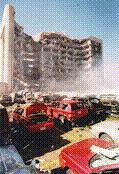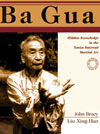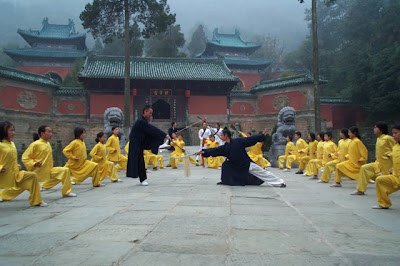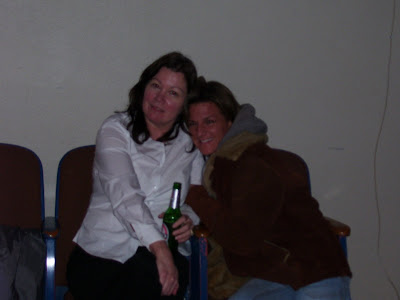Wednesday, February 28, 2007
Hsing-I Two Man Drill
Sifu Rudy and Pals
Hsing-I Instructor
Here is a comparison of the same drill done by different instructors. In pervious posts I have suggested the importance of "live" drills, and these are pretty good examples. Live drills have continuous flow with no stops and starts.
One of the faults in pre-arrainged one-step sparring/self defense patterns is that students, even experianced ones tend to "freeze up" when something changes or somebody makes a mistake in the pattern. People tend to stop, decide who is to blame, unwind and then start over.
While these drills are simplistic and limited, they encourage constant flow, give and take, much like push hands in Tai Chi. This is the hallmark of Internal Martial Arts.
I always enjoy the informal presentation of Sifu Rudy and his crew. If I dig around I think I can find the website for the instructor in the second video, a long time internal arts guy who I believe is based in California.
--(Edit.)
The instructor in the second video is Mike Patterson, who now teaches out of Las Vegas Nevada. Here is a portion of his bio; we will have more of Mike's techniques in future posts--
"ShrFu Patterson was the All Taiwan Full Contact Martial Arts Champion in 1975-1976, an all inclusive contest open to all styles and all ranks. He was the youngest champion ever in the history of the event and retired undefeated. He has since trained Numerous World, International and National Full Contact Champions himself. He served as the West Coast Regional Director of the United States Chinese KuoShu Federation from 1996 to 2001 and now serves as a special advisor for the same organization on the internal martial arts, he was Men’s Coach of the 1996 World Team U.S.A. Inside Kung Fu Magazine chose him as The 1997 Coach Of The Year, having trained so many successful Full Contact KuoShu Fighters for competition. He has trained a total of 25 World, International, National and Regional Chinese KuoShu Full Contact Champions between the years of 1994 and 2000. He retired from this venue of coaching at the end of the year 2000 (at least for the present) to focus more time into teaching and disseminating these internal disciplines. He has served as consultant for military, law enforcement and professional athletics programs."
Monday, February 26, 2007
New Feature:
At the right side of the Blog you will see the new contact e-mail for the Dojo Rat Blog. Want to give us some flack but don't want to show up on the blog? Contact at dojorat@gmail.com.
Saturday, February 24, 2007
LeBell vs. Seagal
Gene LeBell's Powerful Choke
Steven Seagal: You Decide
In the Dojo Rat spirit of unsubstantiated rumor-mongering, we will perpetuate a hotly debated rumor about Steven Seagal getting his ass kicked by "Judo" Gene LeBell.
LeBell is a legendary veteran pro-wrestler, Judo player and trainer of several MMA fighting champions. Here's the version that is probably closest to the truth:
For many years, LeBell worked as a stunt man and fight coordinator in Hollywood. On the set of one of Seagal's crappier movies, LeBell got into a beef with Seagal about Seagal being unnecessarily rough and hurting several stunt men. As the story goes, Seagal had no idea of LeBell's reputation as a fighter. The stunt men had put Seagal on the spot by saying that LeBell could "choke Seagal out". Of course, Seagal said "No one could get close enough to me to ever choke me out". Well, one thing lead to another, and LeBell got ahold of Seagal and really let him have it. As the story goes, Seagal passed out and defecated all over himself. When he came to, he fired LeBell and all the stuntmen.
Now the reason this rumor has been so pervasive is that some people just can't stand Seagal. Sweet vengence.
I trained with an Aikido guy named Robert Button years ago. Robert had gotten his Aikido Black Belt in Tokyo, and trained at the same Dojo as Steven Seagal. He told me he had NEVER been thrown harder in his life than by Steven Seagal. the guy is simply big and strong. So is his ego.
The Hollywood gossip is people are scared of his Mafia connections, and perhaps with good reason. Not only is Seagal rumored to have crossed paths with elements of the Gambino crime family, but also some rogue operatives of shady intelligence agencies that were running guns to the Contras and other fun stuff.
For some of the juicy stuff Seagal hopes nobody ever reads, try this:
http://www.lukeford.net/profiles/profiles/steven_seagal.htm
And here is LeBell's Bio on Wikipedia:
Gene LeBell (born October 9, 1932) is a former American judo champion, instructor, stuntman and professional wrestler. At present, he is associated with Gokor Chivichyan's Hayastan MMA Academy where he teaches MMA/grappling classes.
Fighting as a heavyweight, he won the AAU National Judo Championships both in 1954 and 1955. He has authored a number of books, including The Handbook of Judo (1962), Your Personal Handbook of Self-defense (1964), and Judo and Self-defense for the Young Adult (1971). In 1963, LeBell accepted a public challenge to fight boxer Milo Savage in Salt Lake City. Competing as a "judo/karate" fighter, LeBell defeated Savage, choking him unconscious in the 4th round. In June 1976, LeBell refereed the infamous boxing-versus-wrestling contest between Muhammad Ali and Antonio Inoki. Decades ago, LeBell was a close friend of Bruce Lee, with whom he shared various fighting techniques. More recently, LeBell is credited with contributing to the training of MMA fighter Karo Parisyan.
LeBell is held in high regard by fans of combat sports, to whom he is affectionately known as "Judo" Gene. He received the 2005 Frank Gotch Award, to celebrate the positive recognition he brought to the sport of wrestling.
LeBell has a son named David LeBell.
--- I'll put my money on LeBell...
(edit.)-- Upon review, LeBell won his AAU Judo championships when Seagal was in diapers. And furthermore, any dude that can wear a pink Judo Gi probably deserves to win...
Wednesday, February 21, 2007
The Shadow Government: From Oklahoma City To 911

Affidavit: McVeigh had high-level help
According to Oklahoma bombing conspirator, ranking officials were involved in the attack
By Pamela Manson
The Salt Lake Tribune
Salt Lake Tribune
Article Last Updated:
Oklahoma City bombing conspirator Terry Nichols says a high-ranking FBI official "apparently" was directing Timothy McVeigh in the plot to blow up a government building and might have changed the original target of the attack, according to a new affidavit filed in U.S. District Court in Utah.
The official and other conspirators are being protected by the federal government "in a cover-up to escape its responsibility for the loss of life in Oklahoma," Nichols claims in a Feb. 9 affidavit.
Documents that supposedly help back up his allegations have been sealed to protect information in them, such as Social Security numbers and dates of birth.
The U.S. Attorney's Office in Utah had no comment on the allegations. The FBI and Justice Department in Washington, D.C., also declined comment.
Nichols does not say what motive the government would have to be involved in the bombing.
The affidavit was filed in a lawsuit brought by Salt Lake City attorney Jesse Trentadue, who believes his brother's death in a federal prison was linked to the Oklahoma City bombing. The suit, which seeks documents from the FBI under the federal Freedom of Information Act, alleges that authorities mistook Kenneth Trentadue for a bombing conspirator and that guards killed him in an interrogation that got out of hand.
Trentadue's death a few months after the April 19, 1995, bombing was ruled a suicide after several investigations. The government has adamantly denied any wrongdoing in the death.
In his affidavit, Nichols says he wants to bring closure to the survivors and families of the attack on the Alfred B. Murrah Federal Building, which took 168 lives. He alleges he wrote then-Attorney General John Ashcroft in 2004, offering to help identify all parties who played a role in the bombing but never got a reply.
Nichols is serving a life sentence at the U.S. Penitentiary Administrative Maximum Facility in Florence, Colo. McVeigh, who carried out the bombing, was executed in 2001.
McVeigh and Nichols were the only defendants indicted in the bombing. However, Nichols alleges others were involved.
McVeigh told him he was recruited for undercover missions while serving in the military, according to Nichols. He says he learned sometime in 1995 that there had been a change in bombing target and that McVeigh was upset by that.
"There, in what I believe was an accidental slip of the tongue, McVeigh revealed the identity of a high-ranking FBI official who was apparently directing McVeigh in the bomb plot," Nichols says in the affidavit.
Nichols also says that McVeigh threatened him and his family to force him to rob Roger Moore, an Arkansas gun dealer, of weapons and explosives. He later learned the robbery was staged so Moore, who was in on the phony heist, could deny any knowledge of the bombing plot if the stolen items were traced back to him, Nichols claims.
He adds that Moore allegedly told his attorney that he would not be prosecuted in connection with the bombing because he was a "protected witness."
Moore could not be reached for comment Tuesday.
In addition, Nichols says McVeigh must have had help building the bomb. The device he and McVeigh built the day before the bombing did not resemble the one that ultimately was used, Nichols says, and "displayed a level of expertise and sophistication" that neither man had.
pmanson@sltrib.com
Sunday, February 18, 2007
Taoism And The Martial Arts

I'd like to suggest anyone interested in the history of martial arts to get a hold of a copy of John Bracy and Liu Xing-Han's book, "Bagua: Hidden Knowledge In The Taoist Internal Martial Art".
Books that show technique are great, but the innovation of video has surpassed the book in that area. Books that describe the philosophy, motivation, conflicts, successes and goals of the ancient masters is where we learn the universal truths about our art. This unique book includes both.
Bracy describes in this book how the Taoists, mountain recluses with a history dating back to 500 B.C. influenced the Chinese intellectuals in 1800's China, and a new form of art was born.
In ancient times, warriors were often unkempt and crude, and looked upon with disdain by the upper class. In early studies, the Taoists were, like other alchemists, in search of the elixer of life. That external search became modified into a view that the human body was a microcosm of the universe, and internal yogic alchemy, or "Nei Tan" was practiced. The elixer of life, and rightly so, was believed to be achieved within ones own body. For many centuries in remote areas Taoists practiced this goal, and began to weave the martial skills necessary for survival in with their yogic health traditions, alchemy and mysticism.
It was in the chaotic times approaching 1900 that the intellectuals, generally Confucianist bureaucrats, realized that the "State" could no longer protect them and began to form secret societies and practice the martial arts. The deep analytical systemic thought of the Confucianists blended with the Taoist Yogic martial arts, (after all, why practice a mundane soldiers battlefield art?) and the clans of the upper class began a new level of martial study. It was at this time that the first publications about the internal arts began to emerge.
Communism cast a sooty grey pall over the continent for several generations, and in the late 1970's China was again "open for business". Martial arts had been supressed by the authoritarian government, many masters had been killed through the various conflicts, and many of the ancient skills were nearly lost. Bracy suggests in his book that "Although there are some exceptions, a comprehensively trained, true senior master living in mainland China today must have achieved base proficenicy before 1937".
In some ways, I believe it may at times be necessary to "re-invent the wheel". In our world today, we have more information available than at any other time in history. Our culture is not restrained any longer by narrow fundementalist thought and people are open to paths of enlightenment and deep introspective research.
With these tools in hand, I trust we will keep the old traditions alive and integrate them with new ideas, and our new "wheel" will be better than it ever was.
Bracy's book is widely published and available on Amazon.
Friday, February 16, 2007
Wild Taoist Swordplay

(From "Bagua, Hidden Knowledge In The Taoist Internal Martial Art; by John Bracy and Liu Xing-Han)
"Noted Sinologist John Blofeld describes his meetings with Taoist holy sages and recluses in the mountains of China before the communist takeover of the mainland. Below is an account of Taoists in mock battle he observed one evening while a guest at a Taoist hermitage:
"The climax of the evening was a combat between two pairs of recluses armed with swords. Dark robes billowing in the wind, sleeves flapping like phoenix-wings, they ran and leapt, cut and thrust with such agility that their weapons darting in the moonlight produced spurts of liquid fire. The clash of steel on steel and the flurry of sparks proclaimed that the great swords were no toys; it seemed impossible that the contestants would emerge unwounded from an encounter fierce enough for me to expect to see heads and limbs sundered from their bodies. The blows were no feints, but dealt in earnest in the sure knowledge that the opposing adepts had the speed and skill to protect themselves by parrying or swift avoidance. The combat had the aspect of frenzied ritual in which the contestants were determined to die beneath one another's swords. By the time it ended, I was sweating with anxiety and could scarcely believe my eyes when the four recluses walked towards the Abbot smiling and unscathed."
D.R. : What a fantastic glimpse into another time and place! I will have a follow-up post on John Bracy's Ba Gua book and history of Taoism and the martial arts-- Stay tuned! (as they say in radio)...
Tuesday, February 13, 2007
Push Hands
I know I've been posting a lot of this guy's videos, but Mike Martello just has some of the best examples out there.
Here he is in Taiwan doing push hands with his instructor, who is 81 years old. Keep in mind that Mike is not fighting him, just learning from him.
This goes back to the previous Wing Chun post, where the master included many pushing techniques as well as striking.
Push hands practice is not fighting practice in the direct sense. Internal arts are difficult to learn and rely on extreme sensitivity. If you have ever crossed hands with a very good Tai Chi or Aikido practitioner, you know how they can instantly find your center of balence and center of being. I have been putty in the hands of a skilled Aikijitsu practitioner years ago. I could not feel how he was manipulating me and at any given moment he could have broke or dislocated me in a number of ways. Under the push-hands rules of engagement, my Tai Chi instructor Michael Gilman, an international champion constantly defeats me. As I have described, he can instantly find my center.
Push hands teaches us proper stance and distance from opponent for offense and defense. It teaches us to not "butt heads", power against power. Rather, you learn to follow your opponents energy and utilize it to your advantage.
Remember, when you steal someone's center and really "push" them, every table, chair, stairway and sharp corner in the room becomes your weapon.
Sunday, February 11, 2007
Wing Chun Hand Strikes
Here is a short clip of a Wing Chun Teacher named Gary Lam demonstrating some trapping and striking techniques.
The way I see it, the old cowboy drunken roundhouse punch may be powerful if it connects, but you can see it coming a mile away. Boxing jabs and crosses are much more direct and hard to defend against. Most Wing Chun operates with straight punches, and you gotta love the hand trapping. The hitting is very efficiant, and Wing Chun tends to "Peck people to death" with repeated rapid strikes, rather than use power punching. They also tend to close in and finish with a powerful elbow strike to the head. Also, consider this about the "pushing" techniques: when you take someones center and really "push" them, every table, chair, stairway or sharp corner in the room becomes your weapon.
I see many similarities to certain techniques in the "Backyard Kenpo" post in the dojorat archives, as far as the flow in striking, although Wing Chun remains centerline to centerline and Kenpo does not.
Thursday, February 8, 2007
Snake Strikes of Yin-Style Bagua
I found this fantastic demonstration by an old Bagua master and am excited to share it. One of the posts in the comments has this description:
--The guy is Dr. Xie Peiqi and was the last lineage holder of Yin Style Bagua. He died in 2003. His DVDs are available at www.traditionalstudies.org. --
Indeed, the website above looks to be an excellent resource for internal martial artists and for the history and understanding of Yin-Style Bagua.
The techniques shown in the video will appear familiar to Aikido and Jujitsu people, but note how the entry into these techniques differs than in a Japanese system. Also, if you look closely on a few you will see a few pressure-point strikes, I saw some to the neck in particulear.
We will have more posts on Bagua Kung-Fu coming soon, it is a deep, deep field of study in an obscure but re-emerging internal martial art.
Wednesday, February 7, 2007
Introducing The Rat'ettes

A couple of the Dojo Rat gals dropped by to distract us from our regular training. Needless to say, our training was altered to include some beer drinking. The only thing significant about this is we started drinking really early in the workout.
--The other really fun news is that one of the rats has a serious video camera ready to roll now. I've been trying to do all this with a $124.00 Kodak basic camera and... well, you have seen the results.
The girls have informed us that they are anxious to see some video???, so hopefully it won't take too long to get some quality stuff On Dojo Rat...
Subscribe to:
Posts (Atom)











